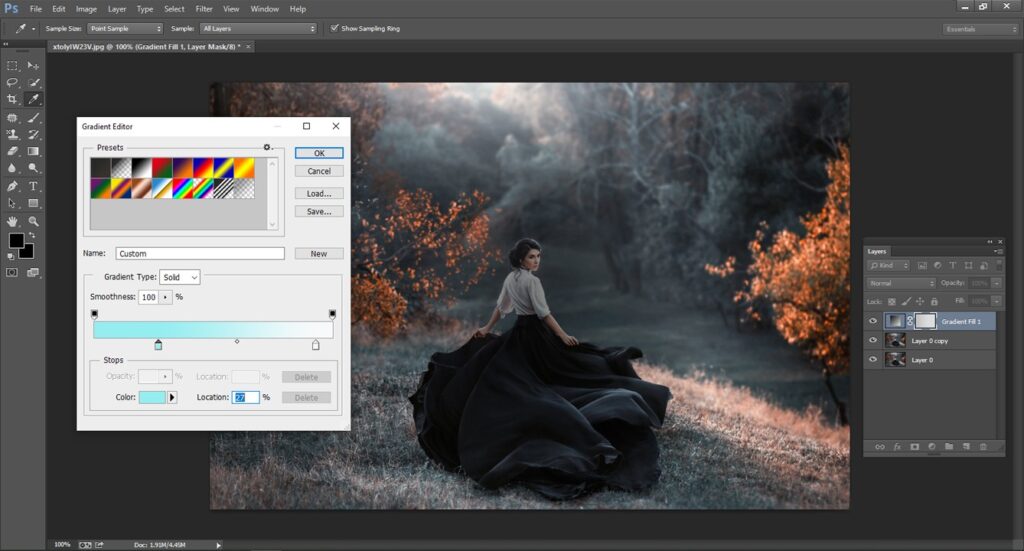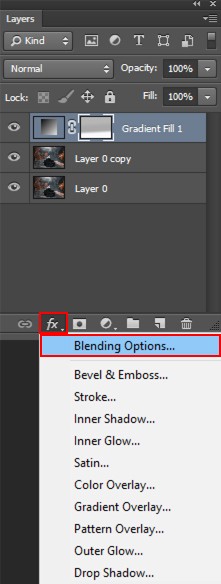Color grading is an amazing place to stylizing a photo and to add a recognizable personal touch to images. In this article, you will come to know about a quick, powerful, and versatile method for color grading your photos by using gradient maps in Photoshop.
Gradient Maps are one of the many useful Adjustment Layers offers by Photoshop. Adjustment Layers are very powerful, not only because they allow the user to precisely adjust things like color and exposure, but because they are also 100% non-destructive. That means you can use as many Adjustment Layers as you want while editing, then adjusts, disable, or delete them at any time without damaging the original image.
Creating a Gradient Map Adjustment Layer, you’ll notice that it converts your photo to black and white. You can use Gradient Maps to change any image into black and white. But it’s not your ultimate goal. You need some color, so let’s take a look at why the image changed to monochrome and how you can add a splash of color.

The heart of Gradient Maps is the Gradient Editor, you can open it by double-clicking on the gradient bar in the Gradient Map properties window. By default, the gradient is set to convert the shadows to black and the highlights to white. The midtones can be converted to various shades of gray depending on their lightness.

How get color?
The Gradient Editor allows doing a number of things. You can choose a premade gradient, you can create your own custom gradient using the tool at the bottom, or you can combine the two options, choosing a premade gradient and then adjusting it to your taste.
Now select a gradient with some color. You can use custom PHLEARN gradients, but any will do. The most amazing thing about gradients is that you can add any number of colors that you want. Now its time to try making your own gradient.

First, select the default gradients and then click the leftmost marker near the shadows of the gradient bar below. Then the Color Picker window will open, it will allow you to select any color you want to assign to the darks of the image. And then continue adding a couple more colors to the gradient by choosing a dark blue. To get realistic results, colors should progress from darkest to lightest going from left to right along the gradient bar. When you choose a color for the brightest highlights, keep the color bright. Or if you’re choosing midtones that are brighter and more near the right side of the bar, choose a lightness that matches.
This is the key to great coloring is preserving the natural tones and character of an image. Don’t completely transform a photo, just make some subtle shifts to the colors to help express a particular tone or mood. Choosing a dark blue, blend with Opacity. Select the Gradient Map layer, locate the Opacity box above the Layers Panel, and dial it down to your choice. You can apply coloring to skin, but colors like greens and blues can make skin look unnatural and can create an unflattering effect. Don’t worry, Photoshop makes it easy to target skin tones separately so your subjects always look their best.

Blend If gives you the ability to affect where a Layer appears in any underlying Layers. Click on the Layer Style (fx)) icon below the Layers Panel and then select Blending Options to access Blend If.

Blend If works based off of luminosity levels, allowing to target and blend the Gradient Map into the highlights or shadows of the image. To use Blend If, just press ALT or OPTN, click on either of the Underlying Layer Sliders, and then drag them along the bar to see the effect. Then dragging from right to left will remove the active Layer from the highlights of the image. And left to right will remove the active Layer from the shadows.
So if you didn’t want the Gradient Map to appear in the highlights of the photograph, you would split rightmost slider and drag it to the left. This will remove the color from the highlights more naturally.
We all know that human skin tones are mixture of reds and oranges. Whenever you need to target the skin tones in a photo, you should look to the red color channel for some help. Blend If allow selecting color channels for blending using the drop-down box next to the Blend If title. Now click on the drop-down box and select the red channel. The colors of the sliders will change to reflect the color channel you have selected.

Press ALT or OPTN, click on the rightmost slider to split it and drag it left towards the middle of the bar. Then it will start to remove the colors from the Gradient Map from the reds in the image. When you adjust the slider, watch the image paying close attention to the skin tones. You can see them shift from the blues and cyans of coloring, back to a normal healthy red.
Gradient Maps have all the qualities of an amazing Photoshop tool. They allow for a high degree of precision, are non-destructive, and provide a professional result. As well as they are easy to use.